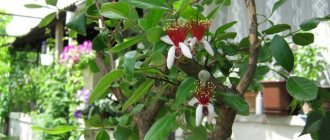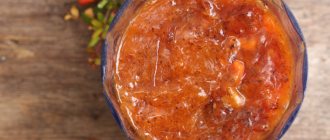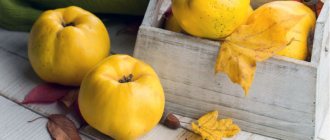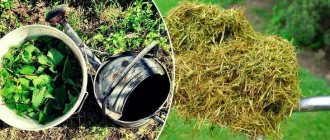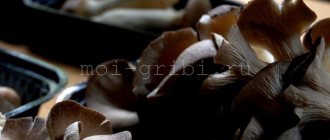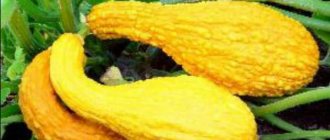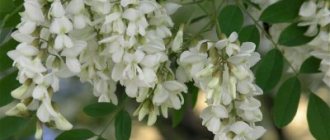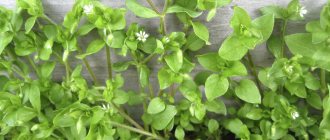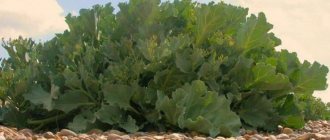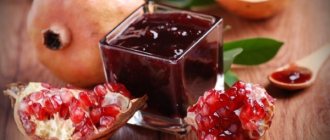How and where does feijoa grow?
Feijoa was first discovered in South America by the Portuguese naturalist Joao da Silva Feijo (a plant new to Europeans was named after his last name). The acquaintance took place in the mid-19th century in the subtropical forests of Brazil. It was later discovered that feijoa also grows in northern Argentina, Colombia and Uruguay. Typical growing area is mountainous subtropical regions. In the tropics it is difficult to grow, so it is extremely rare.
Feijoa grows in the form of large shrubs or small trees with a superficial root system. It is afraid of severe frosts, but can withstand temperatures down to -10 degrees well.
At the end of the 19th century, the first specimens arrived in France; in 1900, the first seedlings were delivered to the Russian Empire and began to grow in Crimea and on the eastern coast of the Black Sea (Sukhumi). After this, the spread of feijoa around the planet went faster - residents of California acquired their own seedlings, and in 1913, the entire Mediterranean region, starting with Italy, began to grow fruit trees and harvest crops.
Where feijoa grows currently: the southern regions of Russia, Armenia, Georgia, Abkhazia, Azerbaijan, Turkmenistan, the Pacific coast of the USA, Australia, New Zealand, southern European countries - Greece, Italy, Spain, Portugal, France.
Interestingly, feijoas are grown not only for harvesting fruits, but also for decoration. The plant has lush beautiful flowers that appear even in indoor conditions.
We grow exotics. Feijoa
Synonyms and local names Akka, pineapple grass; feijoa, pineapple guava - in English; feijoa - in French.
Origin, distribution
Feijoa is native to subtropical areas in South America: Southern Brazil, Northern Argentina, Paraguay, Uruguay. Growing wild, this plant is common in the forests of South America as undergrowth. Feijoa is a typical subtropical plant, and all attempts to cultivate it in the tropics have failed.
This unique fruit and ornamental plant was first discovered in the middle of the last century by the botanist Sellov, from whose surname the species name of the plant comes. And the generic name feijoa comes from the surname of the director of the Brazilian Museum of Natural History - Joani de Silva Fejio.
In 1890, feijoa appeared in France, from where it was brought to Yalta and Sukhumi in 1900, and to California in 1901, where it became relatively widespread. In 1913, this plant took root in Italy, and then spread to other Mediterranean countries. The plant is adapted to the subtropical climate, but it has moved far to the north. For example, in Crimea, feijoa tolerates frosts down to -11C without significant damage.
Currently, feijoa culture is also widespread in Georgia, Azerbaijan, Crimea, and the Krasnodar Territory. However, in most of the above-mentioned areas, feijoa is grown mainly in household plots. Feijoa works well in indoor culture.
Botanical characteristics
The small South American genus Feijoa belongs to the myrtle family (Myrtaceae). It includes only three species, of which only one is common in culture - feijoa (Feijoa sellowiana).
Feijoa is an evergreen shrub with grayish-yellow branches, 2-3 m high. The leaves are opposite, hard, pubescent, green, silver-gray below, with a characteristic odor. The flowers are bisexual, large, crimson-red with white-pink fleshy petals.
The feijoa fruit is a green berry with a reddish tint. The fruits are oval or oblong, 4-6 cm in diameter and 5-10 cm long. The weight of one fruit is 25-50 g. Even when ripe, they have an unassuming greenish color. Externally, feijoa fruits look like greenish plums with a bunch of short tails at the end. In the pulp of the fruit there are four polyspermous nests with numerous seeds, which are not felt when eaten. The pulp of ripe fruits is dense, juicy, sweet and sour with a pleasant aroma. Feijoa is one of the most winter-hardy subtropical plants: it tolerates frosts down to -12, -14C.
Chemical composition
The pulp of feijoa fruits contains sucrose. The acidity of the fruit is quite high. Ripe fruits contain vitamin C, the content of which increases as the fruit ripens. They contain quite a lot of pectin and fiber. A little protein. The amino acid composition of the fruit is not rich, it is represented mainly by 5 amino acids (asparagine, arginine, glutamine, alanine, tyrosine).
A unique feature of feijoa fruits is the ability to accumulate significant amounts of water-soluble iodine compounds that are easily digestible by the human body. In this regard, feijoa is superior to other fruits and berries. However, this is not typical for all areas of the feijoa culture. For example, in Batumi only traces of iodine were found in feijoa fruits.
The fruits are also high in phenolic compounds. Among them are catechins and leukoanthocyanins, soluble tannin, etc., which are found mainly in the skin and give the fruit an astringent taste. However, the skin is easily separated from the pulp and is almost never used for food. The unique strawberry-pineapple aroma of the fruit is due to an essential oil consisting of 93 specific substances.
Therapeutic and prophylactic properties
In scientific and folk medicine, the fruits are used for thyroid disease and atherosclerosis. The fruits are also recommended for use in cases of hypo- and avitaminosis C, inflammatory diseases of the gastrointestinal tract, gastritis, and pyelonephritis. Fresh, boiled or pureed with sugar, feijoa fruits are very useful for people suffering from atherosclerosis.
Feijoa essential oil is used in dermatology as an anti-inflammatory agent.
Purchase
Feijoa fruits are collected unripe, then they ripen during storage. Fruits that are ready to eat are soft to the touch. It is better to use such fruits immediately.
Usage
Thanks to the beautiful large long-blooming flowers and the peculiar silver color of the leaves, feijoa bushes look unusually decorative, so they were initially used for decorative purposes to decorate parks and squares. As an ornamental plant, feijoa is still widespread in the subtropical regions of the Black Sea coast, in Australia, India, Japan, Morocco, Algeria, and California.
Feijoa is famous for the special taste qualities of its fruits and their medicinal and dietary properties.
Unripe fruits contain a large number of hard cells, their taste is low. Ripe fruits have a very tasty whitish pulp of a jelly-like consistency with numerous small seeds and the aroma of strawberries, banana and pineapple. They are used mainly fresh. They are usually eaten with sugar.
Due to its specific taste and aroma, canned food and drinks made from feijoa fruits are very popular. They are also used to prepare preserves, compotes, jam, juices, liqueurs, and soft drinks. In the confectionery industry, the fruits are used to fill sweets.
Serving, etiquette
Feijoa fruits should be peeled before serving. They are usually eaten separately. They are also used as an additive to various fruit and vegetable salads. Grated feijoa fruits with sour cream are a wonderful dessert. Canned feijoa fruits are served along with meat snacks.
Growing at home
It is worth taking cuttings from a grown plant of a “good” variety and trying to root them - with careful care, roots will still form. Semi-lignified shoots 10-12 cm long with 2-3 leaves are used for cuttings. They are cut (after the end of autumn growth) in October-December and must be soaked in a solution of heteroauxin or root for 16-18 hours. The temperature is maintained within 26-28C, air humidity should be very high (90-100%). Since cuttings have to be rooted in autumn and winter, it is necessary to illuminate them with fluorescent lamps, 30-40 cm away from the upper leaves.
When feijoa propagates by seed, any surprises are possible, so even when sowing seeds there is hope of getting fruits in the room. Seeds are sown in cups and placed in microgreenhouses. The seeds are small, so they are planted shallowly, barely covered with soil. The crops are watered from a watering can with a fine strainer, moistening the filter paper placed on the surface of the soil. The best time for sowing is February, and it is advisable to use freshly harvested seeds. After separation from the fruit pulp, it is enough to dry them for 5-6 days, and they are ready for planting. At a temperature of 23-25C, the first shoots appear in 3-4 weeks.
When propagated by cuttings, plants bear fruit in 3-4 years, when sowing seeds - in 5-6 years. Feijoa has the appearance of a spreading shrub - its side branches grow in a variety of directions. However, trimming the shoots and forming a “correct” crown is not recommended. Since flowers and fruits are formed on the branches of the current year, any shortening of the latter will inevitably affect the abundance of flowering and fruiting. You just need to pinch the young plants when they reach a height of 20 cm - this will give the bush a more squat and compact shape.
Feijoa grows quite quickly, and for the first three years it is replanted annually. When replanting, you need to be careful: the branches of the bush are very fragile and break easily. Caution should also be observed when propagating the plant by layering, when the lower branches bend to the ground. Feijoa produces abundant root shoots, which are constantly removed. When transplanting, it can be separated from the mother plant, which will make it possible to use another method of propagation.
Feijoa is quite light-loving, although it can tolerate some shading. In nature it grows on very poor, sandy and rocky soils, but it develops much better on rich and fertile soils.
From time to time, plants are given “sea breezes” - their leaves are carefully sprayed with warm water (on hot summer days and in winter, when the air is very dry). The optimal air temperature in winter is 12-14C.
Like any plant that has adapted in nature to life on poor soils, feijoa is very responsive to applied fertilizers.
“Broad-leaved olive” is little susceptible to diseases and pests. With prolonged waterlogging of the soil, fungal diseases occur. Among the pests, scale insects and spider mites are especially annoying.
When ripe, the fruits turn yellow and red, sometimes orange, and occasionally purple, even black. The fruits look like small cucumbers, with a flower cup remaining at the top - exactly like a pomegranate, which, however, is not surprising: the pomegranate is very close to the myrtle family, to which feijoa belongs.
If the fruits are still hard and unripe and fall off, you should collect them and put them in a dark and warm place - like tomatoes, they ripen well when stored.
Feijoa fruits, depending on the variety, weigh from 20 to 130 g. On garden plantations, up to 30 kg of fruits are harvested from one bush, and in rooms, subject to all agrotechnical rules, their harvest can be 2-3 kg.
Based on materials from gardenia.ru
What do feijoa fruits look like?
Let's start with the fact that feijoa is a berry, although due to its large size people often consider it a fruit. From a nutritional point of view (eating a berry or a fruit) there is no difference, but for general development it is worth knowing and naming it correctly.
Fresh and edible berries have:
- oval shape,
- peel from yellow-green to dark green,
- the surface can be either smooth or pimply,
- length from 2 to 7 centimeters,
- diameter from 1.5 to 5 centimeters,
- weight from 15 to 120 grams,
- sepals on the tail remaining from the flower.
Feijoa is a fruit or berry
Lovers of exotic fruits often ask questions: what is feijoa, where does the fruit grow? Where did this wonderful plant come from? The birthplace of fruitful flowering plants of the Myrtaceae family is considered to be:
Today, agronomists in Azerbaijan, Australia, the Caucasus, and western Georgia successfully grow the fruitful flowering plant on their plantations. Recently, the shrub has been grown in Russia (RF).
What is feijoa - a berry or a fruit? This is an exotic fruit that falls under the category of fruit.
Feijoa is a fruit that will not leave even the most sophisticated gourmet in the world indifferent. The outline of the fruit resembles the shape of an egg. The fruits are colored green. The pulp is characterized by increased juiciness, aroma and a sweetish taste. The taste of feijoa resembles notes of apple, mint, fig and pineapple.
What does feijoa look like? The peel of the exotic fruit is thick and has a tart taste. The pulp contains a small amount of seeds. The fruit can be eaten in its entirety without removing the peel.
Note! Most often, lovers of exotic fruits choose only the pulp, not suspecting that it is the skin that contains the main percentage of useful elements. Some housewives dry the peel in the fresh air and add it to tea together with grated ginger in winter.
How does feijoa bloom? The season of abundant feijoa flowering lasts almost 60 days. During this period, the plant becomes a real decoration of the apartment/garden. Bright feijoa flowers are endowed with an amazing aroma. The fruit ripening period occurs on the 20th of October. During the feijoa ripening season, you can pick the fruit from the tree and eat it right away.
Feijoa - beneficial properties and contraindications
Feijoa fruits contain a lot of useful microelements, thanks to which the berries have a positive effect on a variety of body systems. Let's start with the beneficial properties of feijoa (there are many more of them).
What are the benefits of feijoa:
- Let's start with Yoda. No other land plant can boast a level of 35 micrograms per 100 g of product. As a result, feijoa is recommended for low iodine content and related thyroid problems.
- Eating feijoa helps improve alertness and memory.
- Has a good preventive effect against cancer.
- Feijoa gives a noticeable beneficial effect to people suffering from atherosclerosis.
- Improves the functioning of the immune system. The high content of vitamin C promotes speedy recovery from colds.
- It is useful to eat feijoa for those who suffer from low levels of hemoglobin in the blood, as the fruits are rich in iron. In general, berries help improve blood composition.
- Like many other vegetables and fruits, it improves intestinal function due to its fiber content.
- Eating feijoa is especially useful for those who have high cholesterol levels in the blood, it reduces it.
- Feijoa is especially indicated for general vitamin deficiency. If medieval sailors had the opportunity to use this berry as food on long journeys, then they would not have known about any scurvy.
- Useful for hypertension.
- Feijoa has a beneficial effect on the cardiovascular system of the body.
The benefits of feijoa for the body are enormous, it is difficult to overestimate all its positive effects, but not everything is so simple; any healthy vegetables, berries and fruits can cause big problems if they are consumed incorrectly or in the wrong situation. Be sure to read the contraindications below if you do not want to cause irreparable harm to your health.
Contraindications:
- The main contraindication for feijoa is individual intolerance, causing an allergic reaction. If you are trying the fruit for the first time, then limit yourself to one berry and see how it affects you.
- The berries contain sugar, so it is not recommended to consume them in significant quantities if you have diabetes. The permissible dose should be agreed with your doctor. In severe stages, you will have to give up feijoa altogether.
- Obesity is another category of people who should not abuse feijoa berries. You can eat, but just a little.
- It is not recommended to eat feijoa during pregnancy and breastfeeding without first consulting a doctor.
- Giving feijoa to very young children without first consulting a doctor is also not recommended. For older children there are no special restrictions, unless they have individual intolerance.
- Feijoa is contraindicated for thyrotoxicosis, a disease in which the function of the thyroid gland increases (hyperfunction).
- The remaining restrictions are characteristic of almost all fruits - do not eat spoiled ones, do not overeat.
So, we have looked at the benefits and harms of feijoa, let's see how to eat it correctly.
Benefits of feijoa
The plant can be compared in its usefulness to seafood, since it contains a lot of iodine. At the same time, it is easily digestible. You can get your daily dose of iodine by eating just two feijoa fruits.
In addition to iodine, the fruits of the plant are rich in vitamin C, fiber, pectin and various acids and sugars. They are used in the treatment of various inflammations. Feijoa is useful for diseases of the gastrointestinal tract, liver, pancreas, thyroid gland, and kidneys.
It helps get rid of E. coli or Staphylococcus aureus.
How to choose feijoa
In order not to be disappointed after purchasing a strange berry, it is recommended to pay attention to several points, especially if you are buying for the first time.
- When choosing berries, experts recommend giving preference to larger fruits, since the concentration of nutrients in them is higher.
- The color of the fruit should be uniform, without large brown spots or other spots that could be signs of rotting.
- The peel should be smooth without dents or damage.
- Feijoa should be elastic or firm to the touch. Elasticity indicates that the product is not overripe and is ready for consumption. Firm berries are most likely not yet ripe. Feijoa ripens without problems at room temperature in a few days, so do not be afraid to take slightly unripe goods (the harvest is specially harvested in advance so as not to rot during transportation).
- The softness of the fruit to the touch may indicate that the processes of fermentation and rotting have begun - it is better to refuse such fruits.
- If you have the opportunity to look at the insides of the fruit (ask the seller to cut it), then pay attention to the color of the pulp - it should under no circumstances be brown - this is rotten. The normal option is white (unripe fruit) or transparent cream (ripe).
The berries become most useful and tasty during the ripening period, therefore, when buying unripe feijoa, do not rush to eat it, wait a few days.
How to select and store fruits
When growing feijoa, unripe berries are collected for sale. During transportation and sale, the crop ripens. The soft fruits are ready to eat. If they are hard, they should be placed in a dark place where the air temperature is +20°C or higher. In 3-4 days they will ripen.
The skin of a healthy fruit should be shiny, elastic, without dents or dark spots. When purchasing, you should also look at the color of the pulp:
- white is evidence of an unripe berry;
- translucent - a sign of complete ripeness;
- yellow or brown - a signal about the unsuitability of an overripe fruit, the beginning of fermentation.
Fresh feijoas are stored in the refrigerator for 1.5-2 weeks. During this time, their sugar content increases. With longer storage, the fruits dry out and lose many useful substances. To stop the unwanted process, the berries are frozen.
How to eat feijoa
The consistency of feijoa fruits is not uniform - the strong, hard peel contrasts sharply with the soft, jelly-like interior. This is not an apple or a banana; cutting it into slices and placing it on a plate will not work. Most of all, the berry is similar to kiwi.
This raises the question - how to eat feijoa, with or without peel?
On the one hand, the peel contains a lot of useful elements, on the other hand, its taste is not the best thing about this berry - it is slightly bitter.
To fully enjoy the taste, it is recommended to cut the fruit crosswise and eat the pulp with a teaspoon - this is a universal option.
There is no consensus on how to eat feijoa correctly. If you wish, you can try the peel, but this is not for everyone.
It’s another matter when feijoa is consumed not fresh, but cooked, for example, in jam or salads. In this case, using the peel is highly recommended.
Types and varieties of feijoa
In mid-latitudes, feijoa varieties of foreign or Crimean selection are popular among flower growers. Eg:
- Superba . This plant has very large, fragrant and almost round fruits.
- Coolidge . This cultivar, created by foreign breeders, has oval-elongated fruits.
- Light . This variety is one of the most popular. The shape of the fruits is oval-elongated or oval-round, they are covered with a lumpy peel of a dark green color with a blush. As the berries ripen, the skin becomes lighter. The pulp of such fruits is very tasty and somewhat reminiscent of strawberries.
- Nikitskaya . Externally, this plant is similar to the Svetlaya variety of feijoa. The taste of the berry pulp is sweet and sour and refreshing.
- Lumpy . Inside the lumpy, round-shaped berries there are few seeds.
- Early fragrant . The berries are covered with a smooth peel, their pulp is fragrant and tender, with a sweetish-sour taste. There are a lot of seeds inside them.
- Firstborn 120 . This mid-late variety has not very large berries of various shapes, which are covered with a greenish-yellow peel. There are a lot of seeds inside the berries.
Also popular among flower growers are the following varieties: feijoa Nikitskaya 42, Nikitskaya 3, Crimean early, Yaltinskaya, Andre and Choiceash.
Feijoa photo
Photos of feijoa fruits (berries).
How feijoa grows: photo of tree and bush.
Photo of feijoa flowers. They are very beautiful.
During the flowering period, the entire tree or bush is strewn with lush, bright, large flowers and it looks stunning.
Brief description of cultivation
- Bloom . In spring or summer, its duration is about 20 days.
- Landing . The seeds are planted in a container in the last days of winter or in the first weeks of spring.
- Illumination . The light should be bright, but diffused.
- Temperature regime . Normal room temperature.
- Watering . Watering should be bottom (through a tray) and systematic.
- Air humidity . The humidity level should be higher than normal room humidity. In winter, during the heating period, the bushes need to be moistened with a spray bottle every day in the evening with lukewarm water.
- Fertilizer . You need to feed it systematically once every half month with organic matter (a solution of bird droppings (1:15) or mullein (1:10)). And mineral fertilizers can be used for this only in case of emergency.
- Rest period . When grown indoors, this period is not clearly expressed.
- Transplant . Before the bushes turn 3 years old, they need to be replanted once a year. Adult specimens need to be replanted much less frequently, or rather, once every 5 years, but the top layer of soil mixture in the container must be replaced every year.
- Trimming . In late autumn or at the beginning of spring, after the height of the bushes is from 25 to 30 centimeters, they will need to be shortened by 1/3. Crown shaping and sanitary pruning should be done at the same time as necessary.
- Reproduction . Cuttings and seed method.
- Harmful insects . False scale insects and red spider mites.
- Diseases . Gray rot.
- Properties . The fruits of this plant contain substances that are very beneficial for the human body.
Feijoa - recipes
We have looked at how to eat feijoa fresh, now we will look at several cooking recipes that will not only diversify the taste properties of the berry, but also preserve a lot of useful substances in the fruit through the use of the peel.
Feijoa jam without cooking (feijoa pureed with sugar)
Preparing jam without heat treatment allows you to preserve the maximum of vitamins contained in feijoa fruits, but imposes storage restrictions - you should only keep it in the refrigerator, where tightly closed jars will last all winter.
The recipe for feijoa with sugar is very simple:
- 1 kg of berries;
- 1 kg sugar;
The berries should be washed first. If there are large dark spots on the skin, it is better to remove them. Sometimes it is recommended to pour boiling water over it - this is not necessary, but it will not make it worse. Dry.
Cut the finished fruits in half - this will allow you to identify spoiled specimens and prevent them from falling into the common “cauldron”. Trim the tip with the remains of the inflorescence.
Next, we grind the feijoa using a meat grinder or blender; in our age of technology, I don’t mention a grater, although you can use it.
Mix the resulting mass of pureed feijoa with granulated sugar until the latter is completely dissolved. Prepare dry, clean jars and put the resulting jam in them and close with tight lids. It is better to use small jars so that the jam does not sit for a long time after opening.
Over time, the surface of the jam may darken, there is nothing wrong with that - this is the result of the oxidation of iron and iodine, which are abundant in feijoa.
You can eat it immediately, but put it in the refrigerator for storage.
Feijoa compote for the winter
Thanks to the wonderful strawberry flavor of feijoa berries, they make a wonderful compote. It will be a wonderful addition to the holiday table and for every day. Feijoa ripens in November and the compote prepared from it is just in time for the New Year - it is much healthier and tastier than store-bought juices and, especially, soda.
To prepare 3 liters you need:
- 600 grams of feijoa berries;
- 2.2 liters of water
- 200 grams of sugar (you can add a little if you like it sweeter);
- 0.5 teaspoon of citric acid (if you don’t like sourness, you can reduce it by 2 times).
The berries should be washed well and the ends with inflorescences should be trimmed. After that, put them in a 3-liter jar. Boil water and fill it with boiling water to the top.
Let it brew for about an hour, during which time the water cools.
Pour the resulting first infusion into a saucepan and add sugar - cook this syrup for about half an hour, pour in citric acid at the end.
Pour the berries into the jars again and roll them up with tin lids. We turn the cylinders over and cover them with a blanket. In such “insulation” the compote should stand for 24 hours.
The resulting feijoa compote will reach maximum saturation in 1.5-2 months.
Feijoa compote for every day
For everyday use, compote does not have to be rolled into jars. For 3 liters of compote we take the following ingredients:
- Feijoa berries – 0.5 kg;
- Water – 2 liters;
- Sugar – 150-180 g.
The fruits need to be washed and the tails of the flowers trimmed. Cut it in half; you shouldn’t chop it too much, as the insides of the berry are very soft and you’ll simply crush it.
Place the berries in a saucepan, add water and add sugar. After boiling, leave to simmer over low heat for half an hour. After half an hour, turn it off and let it brew for a couple of hours. Feijoa compote is ready.
Feijoa recipe with honey to improve immunity
The method of preparing feijoa with honey is very similar to the recipe with sugar, only the beneficial properties of this product are an order of magnitude greater. This mixture is used not as jam, but as a therapeutic and prophylactic agent - 2-3 teaspoons per day.
To prepare you need:
- 1 kg feijoa;
- 1 kg of honey;
We thoroughly wash the berries and cut off the tail of the inflorescence. If there are large dark spots on the peel, then we get rid of them.
It is worth cutting each fruit in half before proceeding with further chopping in order to identify spoiled berries.
Grind the feijoa in a meat grinder or blender until it becomes a paste.
Mix the ground berries with honey in equal proportions until a homogeneous mass is obtained. This product should be stored in the refrigerator and eaten in small portions - this is an excellent prevention of colds and many other diseases.
If desired, the recipe for feijoa with honey can easily be supplemented with other ingredients, for example, walnuts go well together. They are ground together with berries, as a result the taste becomes more interesting.
Feijoa in cosmetology
The fruits smooth out fine wrinkles, slow down aging, and are used to scrub and moisturize the skin, protecting it from environmental influences.
Face masks
The basis is puree made from pulp. By adding various ingredients, you can obtain compositions with a wide range of properties:
- Honey with vegetable oil will help you rejuvenate.
- Sea buckthorn with crushed rolled oats flakes will relieve fatigue.
- Starch, lemon juice (2 drops) will eliminate pigment spots.
- Cottage cheese with cream will moisturize the skin.
Apply the mixture in a thick layer and leave for 20 minutes. Rinse off with warm water. Wipe your face, neck, and décolleté with the pulp of an exotic fruit. The procedure should be done in winter in courses 3 times a week.
Feijoa - growing at home
Sometimes, readers are interested in how to grow feijoa at home? At first glance, the task is not simple, since the plant is very whimsical, but nothing is impossible and, with proper theoretical preparation, you will cope with this task.
It will be possible to get fruits from a plant planted with a seed no earlier than after 5 years; a feijoa cutting can begin to bear fruit after 4 years.
Let's start with the soil. Feijoa loves loose soil rich in humus. Excess lime is not desirable, since myrtle plants, which include feijoa, do not tolerate it well - slightly acidic soil is needed. Good drainage when planting is required. In summer, it is necessary to regularly water and fertilize the plant in a pot, since drying out the soil will lead to the fall of leaves and ovaries (if they appear).
For wintering, feijoas should be moved to a cool room with an air temperature of +10 degrees. If you have an insulated loggia, then this option is ideal. In winter, regular watering is also necessary, but in small quantities, so as not to cause rotting of the root system, since the roots do not absorb moisture as actively in winter.
Remember that feijoa comes from the subtropics and loves light, so it needs to be grown on southern windowsills, where there is always a lot of light.
Growing from cuttings
It is best to start cuttings in late spring - early summer.
Semi-lignified parts of the crown of the mother plant, 8-10 centimeters long with 2-3 internodes, are used as cuttings, leaving only the top pair of leaves.
We use leaf humus and river sand as a substrate. You can use other options, but this one is time-tested and works flawlessly. You can use a regular ceramic pot as a vessel.
The cutting is planted 2/3 of its length at an angle. After planting, we water the seedling with potassium permanganate. The optimal solution temperature is around 30 degrees.
In order for the cuttings to take root well, it is necessary to create a moist environment for them; a plastic bottle covering the entire farm from above like a cap is suitable for this. Periodically it is necessary to remove the cap and ventilate the cuttings.
The plant requires a lot of light, but it must be diffused.
Rooting usually takes 2 months, after which the seedlings can be transferred to the regular soil described above.
When the seedlings grow to 25 centimeters, it is recommended to cut off the top third. This is necessary for the formation of a strong skeleton and crown of the future feijoa tree. It is best to grow feijoa at home as a tree; for this purpose, all new shoots at the root collar must be removed, leaving only the main trunk.
Growing feijoa from seeds
First you need to extract the seeds from the berries. Only ripe fruit is suitable for this, but not overripe. The lower part of the fruit is carefully cut off a few millimeters with a sharp knife. The jelly-like pulp is then squeezed out through this cut.
As a rule, there are not many seeds. They must be washed in a weak solution of potassium permanganate until the surrounding mass is completely removed. Let's dry it.
Any air- and water-permeable substrate is suitable for sowing. It is worth sowing to a depth of no more than 5 mm. It is recommended to moisten the soil with seeds using a sprayer, as a watering can can wash them out.
If sowing occurs in the warm season, germination will occur in 12-15 days.
After 4 pairs of leaves appear, the sprouts can be transplanted to a permanent place in nutritious soil.
Pests and diseases of feijoa
Feijoa - what kind of tree is it, what does it look like
The culture's resistance to diseases is assessed as high. If you follow standard agricultural techniques and create optimal conditions for growth, you don’t have to worry about the plant being affected by diseases. The main reasons for the appearance of diseases, for example, gray rot, are violations of the watering regime. Leaf spotting is even less common.
If the plant shows signs of a fungal disease, it is treated with Bordeaux mixture. The affected areas should be carefully cut out, including healthy tissue. However, this does not eliminate the need to restore the correct watering regime. Fungicide treatment is a measure to maintain the vitality of the crown, but the roots need a regular, but not excessive, supply of moisture.
Traces of fungal disease on feijoa leaves
Of the indoor pests, feijoa is most threatened by spider mites, scale insects and false scale insects. They pose the greatest threat to young foliage and shoots. For etching, a solution of keltan is used. The drug is diluted in a proportion of 2 g per 1 liter of water.
Note! Treatment is best done in the evenings to avoid sunburn on wet foliage.
Re-etching is carried out after 40 days, if necessary. Regular warm showers are another measure to prevent ticks.
The false scale insect can be detected by careful inspection on the front surface of the leaves along the midribs. The most effective means of pest control is karbofos, which is diluted in a proportion of 5-6 g per 1 liter of water. The solution is used to spray the crown from all sides. One treatment is not a sufficient measure; it is repeated 2-3 times with an interval of 5-7 days.
Scale on a leaf
FAQ
Feijoa is a very interesting and, at the same time, little-known plant for us, so questions related to it often arise - we will try to answer the most popular ones in question-answer mode.
Feijoa fruit or berry?
Feijoa fruits are quite large for berries, so many people consider them fruits, but this is wrong - feijoa is a berry.
What vitamins do feijoas contain?
100 grams of feijoa contains the following vitamins (the average figures are given, which may differ depending on the variety and place of growth):
- Vitamin C – 32.9 mg
- Vitamin E – 0.16 mg
- Vitamin K – 3.5 mcg
- Pantothenic acid – 0.223 mcg
- Niocin – 0.295 mcg
- Pyridoxine – 0.067 mcg
- Riboflavin – 0.018 mcg
- Thiamine – 0.5 mcg
- Folate – 23 mcg
Minerals:
- Potassium – 0.155 mg
- Iodine – 0.3 mg
- Phosphorus – 20 mg
- Calcium – 17 mg
- Magnesium – 9 mg
- Sodium – 3 mg
- Manganese – 0.085 mg
- Iron – 0.08 mg
- Zinc – 0.04 mg
- Copper – 0.055 mg
Feijoa calories
The calorie content of feijoa is 49 kcal per 100 grams of product. Moreover, the berries consist of the following:
- Carbohydrates – 10-15 g;
- Proteins – 1-2 g;
- Fats – 0.6-0.8 g;
- Fiber – 6-7 g.
How to eat feijoa - with or without peel?
From a nutritional point of view, feijoa berries are completely edible, including the peel. But not everyone likes the peel for its taste, so it is rarely eaten raw, but when preparing jam or compotes, the fruits are used completely.
Ultimately, everyone decides how to consume feijoa independently based on their taste preferences - there are no contraindications.
What does feijoa taste like?
Feijoa tastes like a cross between strawberries, pineapple and kiwi - a sweet berry with a slight sourness. The presence of a large number of microelements gives the fruits some astringency.
How and for how long is feijoa stored?
Ripe fruits should be stored in the refrigerator for no more than a day, as they overripe and spoil quite quickly. If the berries were purchased unripe (hard to the touch), they should be stored at room temperature until ripe, usually 2-3 days.
How do you feel about feijoa: have you tried it or not, do you like the berry, do you make jam or compote from it, what recipes do you use?
For dessert, watch an educational program about Feijoa, which was broadcast on Channel 1:
Feijoa propagation
The seed propagation method is used quite rarely, since it will take at least 6 years to wait for flowering and fruiting, which for many gardeners and flower growers is too long a period. If you want to get your first harvest as soon as possible, you should use the popular cutting method. To do this, you will need a plant that has already reached maturity, over 6 years old.
Feijoa cuttings
The optimal time for cutting cuttings for propagation purposes is winter, preferably February, when daylight hours are already beginning to increase and the number of sunny days is growing. To cut future planting material, select the middle part of the crown.
Note! The twigs that are ideal for cuttings have half-lignified bark. Completely lignified or without wood are not suitable.
The second important sign is the number of internodes; there must be at least 3 of them. Cutting sections must be treated with a root formation stimulator, and the tree must be sprayed with a fungicide solution to avoid infection.
Cuttings are traditionally rooted in small containers with a soil mixture, to which coconut fiber, vermiculite, and coarse river sand must be added. The result should be fertile (black without brown), very loose soil, well permeable to moisture and capable of retaining it.
Planted cuttings must be covered with caps made of glass jars or plastic bags. Once a day they will need to be opened for ventilation. This will help maintain an optimal level of air humidity around the plants. The best temperature at this time is 23-25 °C.
Important! The duration of rooting is 2-3 months, but not all specimens will successfully take root. That is why it is necessary to simultaneously root several branches at once in order to have a guarantee of success.
You can grow the subtropical feijoa plant in your garden, on a windowsill in a pot, or in a greenhouse in a tub. Fruiting usually occurs in the 6th year, but it can be brought closer. A flowering bush or tree pleases the owner for six months with its attractive appearance and slowly ripening tasty and healthy fruits.
What it looks like: varieties and varieties with photos
Flower growers from middle latitudes prefer to choose plant varieties of Crimean or foreign selection:
- Superba . They are distinguished by large and fragrant fruits.
- Nikitskaya . The berry pulp is rich, with a sweet and sour refreshing taste.
- Light . One of the most popular varieties. The fruits are oval-elongated with a rich sweet taste reminiscent of strawberries.
- Firstborn 120 . A mid-late variety with medium-sized berries of various shapes. The fruits are rich in seeds.
Superba:
Nikitskaya:
Light:
Firstborn 120:
Benefits and harms
Are figs a fruit or a berry? What is a fig or fig?
Feijoa - not everyone knows what it is and how useful the fruit is. Among the main beneficial properties that the exotic fruit has, a large percentage of the fruit contains:
- B vitamins;
- vitamin C;
- vitamin PP;
- iodine and calcium;
- potassium and sodium;
- magnesium and phosphorus;
- iron and copper;
- zinc and manganese;
- malic and folic acid;
- strawberry and pineapple essential oils.
Due to the easy digestion of proteins and fats, which are concentrated in the pulp of the ripened fruit, fruits are often used in the diet by adherents of proper nutrition. To lose weight, nutritionists often recommend replacing your evening meal with a small amount of fruit. Such a dinner will provide an opportunity not only to reduce body weight, but also to compensate for the deficiency of useful elements.
Shrub growing in Crimea
Important! It is worth considering that the percentage of iodine in feijoa exceeds its amount in any seafood. Due to its presence in a water-soluble state, the body can easily absorb it.
Doctors recommend including citrus in the daily diet for people suffering from pathologies:
- thyroid gland;
- gastrointestinal tract;
- kidneys and liver.
Note! In Georgia, “Natakhtari” lemonade is made from feijoa, a national drink that is in great demand among local residents and tourists. And in Russia, young people love the energy drink “Darkside” with feijoa, which has an indescribable taste and aroma, and also energizes them.
The cahetin and leukoanthocin contained in the composition act on the human body as a powerful antioxidant, which helps prevent the occurrence of malignant tumors. The presence of vitamin C in the composition makes it possible to cope with colds, symptoms of acute respiratory disease and flu at an early stage.
Note! Feijoa is an excellent immunomodulator that grows in nature.
Despite the abundance of beneficial properties, the fruit can be harmful to human health. A large percentage of sugar content in the product negatively affects the health of people who suffer from:
- obesity;
- diabetes mellitus;
- heart disease;
- ulcerative pathology;
- individual intolerance to the fruit;
- hyperfunction of the thyroid gland.
If you feast on a large number of exotic fruits every day, you can provoke the occurrence of:
- anxiety;
- nervous breakdown;
- “jumping” temperature;
- rapid heartbeat;
- decreased performance;
- depressed state.
To avoid problems with stool, it is better to avoid the combination of cow's milk and feijoa. Fruits can only be eaten fresh! After 6-7 days of storage, the product deteriorates and can cause poisoning.
